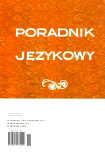Aspekt kulturoznawczy współczesnej etymologii
Cultural Aspect of Contemporary Etymology
Author(s): Włodzimierz PiankaSubject(s): Language and Literature Studies
Published by: Dom Wydawniczy ELIPSA
Keywords: współczesna etymologia; aspekt kulturowy etymologii; Ferdinand de Saussure; W.M. Illicz-Switycz; Witold Boryś; Ignacy Ryszard Danka; etnogeneza Słowian; A. Brückner
Summary/Abstract: Etymology which originated as one of the oldest branch in Slavic linguistics, has serious delays in applying the achievements of important scientifi c theories (F. De Saussure’s laryngeal theory, V.M. Illich-Svitych’s nostratic theory) whereas cultural studies, a recent discipline which enables its application in fragments, is used increasingly (T.V. Gamkrelidze, V.V. Ivanov, O.N. Trubachev or W. Boryś). The cultural aspect, connected with semantics, was used earlier by some researchers but never systemically. In semantic-cultural microsystems researchers should study in the fi rst place the basic oppositions expressed derivationally (CSl. *ov-ь-ca ‛sheep’ – Pol. owca : CSl. *ov-ь-пъ – Serb. ovan, Pol. baran ‛ram’) and lexically (IE *gwen- -e-H2 > *gen-ā-ø from *gwen- > *gen- ‛to give birth’ > žena ‛woman’ > żona ‛wife’: *man-gio or *man-gĭ – from *man-(g-) ‛to jutt out, to project, to lift’ > *mǫžь ‛man’ > mąż ‛husband’. In this case the role difference in procreation was initially lexically expressed and was precised by means of woman’s and man’s anatomic features. The fi rst example shows the oppositions under the category of gender which is expressed with a developed derivational system. Trans. A. Gierba
Journal: Poradnik Językowy
- Issue Year: 2010
- Issue No: 07
- Page Range: 14-26
- Page Count: 13
- Language: Polish
- Content File-PDF

